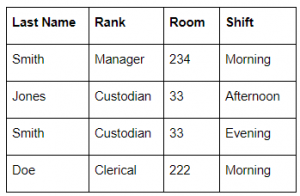Queues-and-Stacks
December 26, 2023Question 2130 – JT(IT) 2016 PART-A General Aptitude
December 27, 2023Relational-databases
| Question 27 |
Consider the following table in a relational database


| {Last Name} | |
| {Room} | |
| {Shift} | |
| {Room, Shift} |
Question 27 Explanation:
→ Candidate means uniquely identified key.
→ In the above table, Room having duplicate values. So, we can’t say room is candidate key
→ The last name also having duplicates. So, we can’t say the last name is candidate key.
→ Shift also having duplicate keys, so we can’t say shift also a candidate key.
→ Combining Room and Shift we can say that candidate key.
→ In the above table, Room having duplicate values. So, we can’t say room is candidate key
→ The last name also having duplicates. So, we can’t say the last name is candidate key.
→ Shift also having duplicate keys, so we can’t say shift also a candidate key.
→ Combining Room and Shift we can say that candidate key.
Correct Answer: D
Question 27 Explanation:
→ Candidate means uniquely identified key.
→ In the above table, Room having duplicate values. So, we can’t say room is candidate key
→ The last name also having duplicates. So, we can’t say the last name is candidate key.
→ Shift also having duplicate keys, so we can’t say shift also a candidate key.
→ Combining Room and Shift we can say that candidate key.
→ In the above table, Room having duplicate values. So, we can’t say room is candidate key
→ The last name also having duplicates. So, we can’t say the last name is candidate key.
→ Shift also having duplicate keys, so we can’t say shift also a candidate key.
→ Combining Room and Shift we can say that candidate key.
